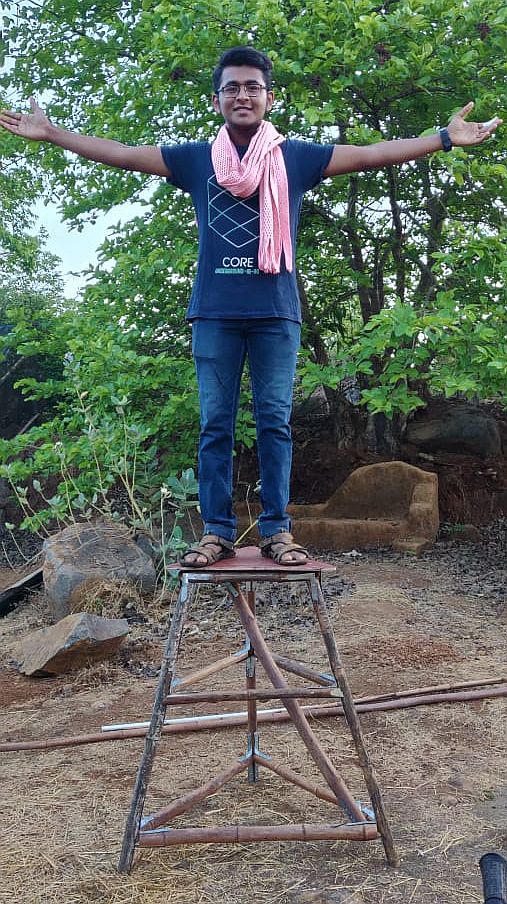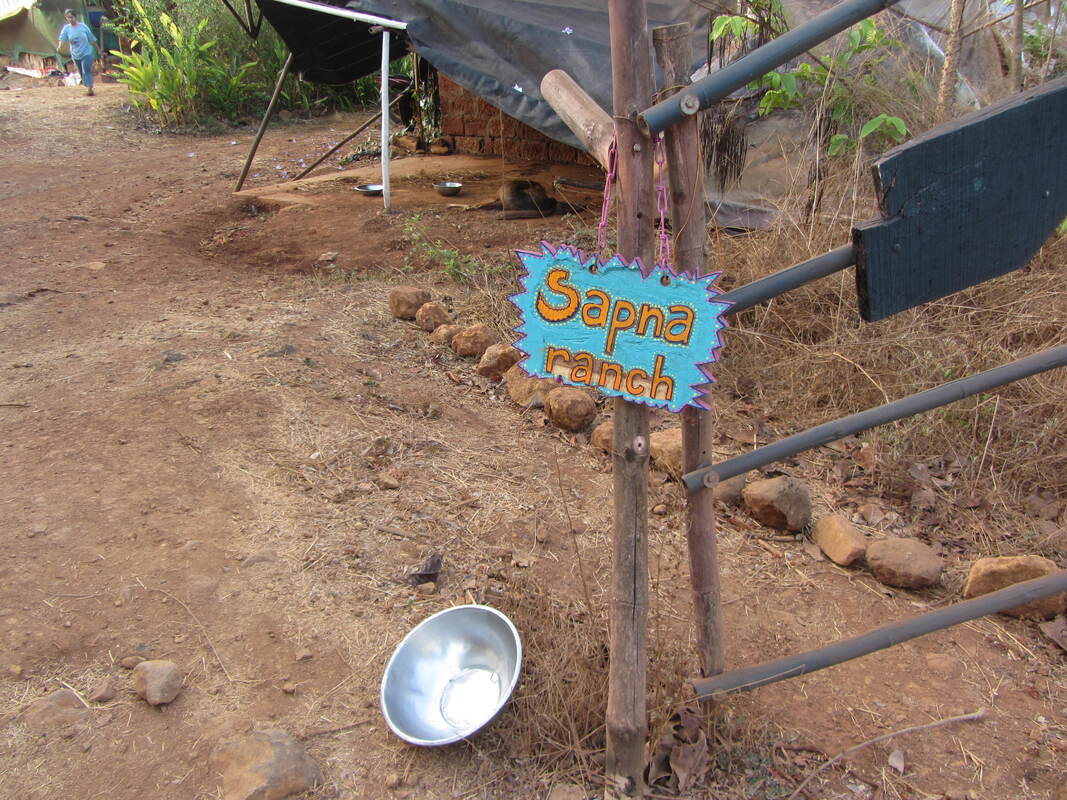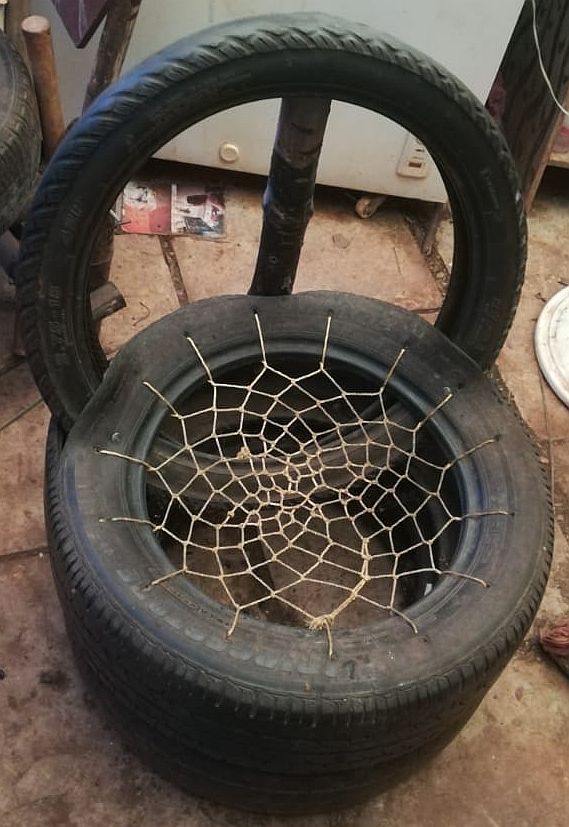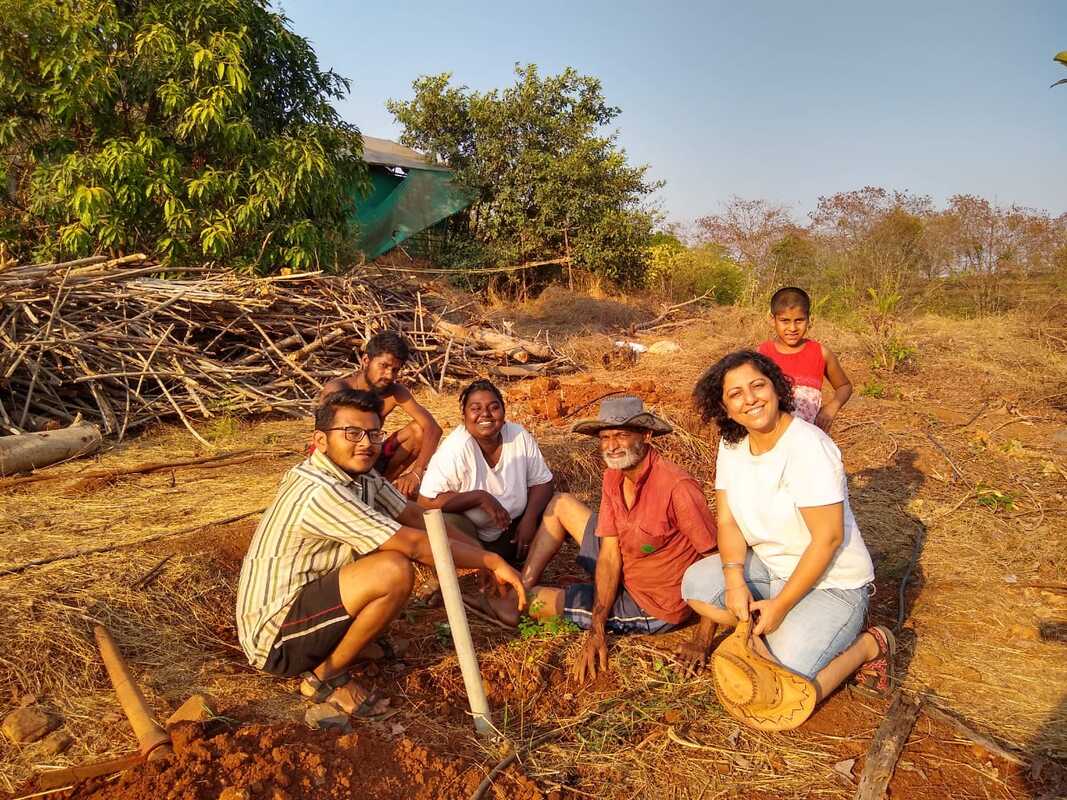|
He was not the only one to crack this year's entrance examination to the National Institute of Design (NID), considered one of the toughest tests in the country. As a veteran designer put it, it requires formal training and extraordinary skills of observation and design thinking. However, teenager Prasad was likely the only one who passed it without any formal preparation, except for making things like a triangular stool and a tyre chair, living in a remote ranch and simply going with the flow. This story is about Prasad and Sapna Ranch, which attracts, as Hasmukh puts it, “creative problem solvers” of the world to live life their way and in harmony with nature. PRASAD I was born in Goregaon, a small town in Mangaon taluka, Raigad, Maharashtra. I spent the first seven years of my life here and then we shifted to Panvel, where my dad had many clients. After three years we moved back to Goregaon, where I live now with my mother. I have no sibling. My school life was an interesting mix of cultures, languages, and learning styles. Starting out in Goregaon, I changed schools frequently for different reasons. I have studied in a traditional Marathi medium school, a semi-English-medium school, and a convent school. Now, after completing my XII, I have secured admission to the National Institute of Design (NID). Once my mom and I went to a home-schooling conference at Sane Guruji National Memorial School. Hasmukh was there to talk to us about home schooling. He made a lot of references to Sapna Ranch and how learning happens there. That’s when I got interested. I spoke to Hasmukh and promised him I would surely visit the ranch once. HASMUKH During that session I met several parents and their children. Many of them showed interest, including Prasad. He was the only one who actually came from that group and that too after some time. Prasad came and stayed back, and I really did not have any expectations. PRASAD My expectation of the place was some people would be working and some children learning. But no, it was completely different. A kid was firing up a Himalayan rocket and someone was telling him how it was made and how it works. Some foreign volunteers were working on the geodome. We met them and we had sherbet with them, which Hasmukh was preparing when we reached there. I was surprised that the person I saw at the school conference was making sherbet for us. It was so amazing. So, we washed our glasses and put those away. We understood how the ranch works, the community there and the thought behind the whole thing. I came to know about the ranch in May 2018 and my first visit was in November 2018, when I was about 17. My first stay at the ranch was in May 2019. I was under some stress for some reason. My mom dropped me there. One of the regulars at the ranch came and asked me if I was staying there. Then she just sprayed me with water from a pipe and then everyone else also poured water all over me. I felt as if I had been living there for 10 years. Hasmukh came and hugged me and we started working on something immediately. Then he started showing me stuff and how things were working. There were about ten people already when I arrived at the ranch. Everyone was talking to me. It felt as if we had known each other for the last ten to twelve years. That night I was talking to them on a lot of subjects. The conversations were about me, how they were spending their time, and how I got to know about the ranch. I am a card magician, so I showed them some stuff. I also showed them some of my drawings. The most memorable interaction was with the animals. I have never seen so many animals in one place. Dogs and cats fight with each other but here there were three dogs and seven to eight cats, all living in peace with ten humans and that was amazing. HASMUKH People who come to Sapna Ranch come with zero expectations and I accept people with zero expectations. Prasad seemed interested. His conversations were interesting. He showed that he wanted to learn, and I gave him the space the same way I give for everybody. It was not that Prasad was an exception. Once he came here, he looked at things. He started observing and working on whatever projects we had going and then he asked me about most of the stuff at the ranch. PRASAD My house is only 45 minutes away from the ranch. So, my visits to the ranch are very frequent. I am lucky about that. I have been going to the ranch for the past two years as and when I get two or three days free. My stays have ranged from a day and a night to three months at a stretch—March to May 2020. I have seen the ranch in all seasons. My first interactions with Hasmukh were very interesting. At the conference, where I met Hasmukh I was just listening to him. Talking to him was a completely game-changing experience. He is into science. I am a science nerd and so we were always talking about science. I do not have many friends and I am not into many things young people are into, social media included. For me, the ranch is not a getaway but my home. Sometimes, when I am going home, I tell Hasmukh I am going for a vacation. I try to look for the ranch outside the ranch—similar values, similar people, and similar thoughts. I connect with them and study them so that I can be a better person and contribute to the world. The traits of a rancher have been inside me from my childhood. I started travelling at the age of thirteen or fourteen. I was doing a lot of trekking, mountaineering in the Himalayas also. I used to stay away for months and my mother was used to that. She was happy that I had found a place so heartily amazing. My teachers were amazed because I was one of the few students who, instead of being focused on marks was wondering where to use this theorem or apply that theory. My marks were average. One of my teachers visited the ranch and loved the place. The way people look at you changes completely when you start talking about the ranch. Previously they were looking at you as a disturbed person, living your life as the other 99%. When you tell them about the ranch, they start looking at you as a unique person. Actually, everyone is unique but very few realize that. There are many memorable things that I have done at the ranch. Like the forest fire we doused in March 2020. It was a great learning experience—how not to panic, stay calm and handle a disastrous situation. The other one was when I completed the triangular stool in May 2019. From the designing to standing on the stool to show how strong it was. That was completely unique because I had never made a product from start to end. I designed it, studied it, re-designed it, modelled it, and made it in just three hours. I also estimated its costing with help from Hasmukh. I will get into product designing in future. HASMUKH I told Prasad that the triangle is the strongest two-dimensional structure. After some time, Prasad mentioned to me that he wanted to make a stool whose top was triangular, the base was triangular, and it would have three legs. That was just the day before he left. He started on that stool and within a day he had completed it, more or less on his own. I shared some stabilisation ideas from my experience, and he implemented those. He completed it at eleven in the night or something and his dedication did impress me. And then the next day before he left, he stood on that stool. He told me how happy he was because until that time nobody had given him an opportunity to do what he wanted. Everybody just told him what he should do, nobody asked him what he himself wanted to do. So, creating that stool was a milestone for him. The stool is still in use at Sapna Ranch and it is as sturdy as it was on the day he made it. Prasad is willing to learn anything and everything. Here, he learnt electrical, plumbing, and cement work and he got good at it. We fixed the roof of the invertor room. We made a chair from used tyres. He had an idea to cut a tyre and making a backrest. I had never tried it. We gave it a shot and it worked out very well. What I also like about him is he is willing to work with small kids and big people. He has a very mature head on his shoulders. PRASAD When I first came to the ranch, I had thought I would get amazing plans. That I would have a list of stuff when I came back home, and I would be ready to face the world. But my most important lesson was finding the flow inside me and just going with it. Here you become more patient, learn to listen more. You develop a different level of understanding, of empathy. Another important lesson was learning and teaching. Even my teachers remarked that there was a difference in the way I was learning. When you understand how to learn, it is easy to teach. Earlier I used to boast about my knowledge and people would get bored of my explanation of things. Now they don’t. They appreciate my attitude. HASMUKH We discussed about his career, including options abroad. I was keen that he should have the entire world as his palette. If he were interested, I could have helped him get scholarships from some universities abroad. We even discussed about the option of taking a gap year which I thought would do him good. I did not restrict him to Sapna Ranch. If there was another place that interested him, I would help him go there. He was also looking at architecture. But the test schedule did not work out because of the Covid problem. There was also an opportunity in the US. I was there to put the options before him, and the choice was his. I knew that he was going to get into NID because he is pretty bright from that perspective. PRASAD I had no idea about my career even a month before NID. Architecture? Film making? Product design? I would speak to Hasmukh. I would talk to myself. I did not even know about NID two years ago. A friend told me about it, and I thought of giving it a shot. I had heard from a lot of people that NID worked on experiential learning, giving more importance to progress than marks. I thought that was like my experience at the ranch. Hasmukh also told me that at NID, you are completely immersed in the design environment. I did not do a thing for preparing for the entrance. There was no class, no books, and no consultation with any experts. My friend had got me some books, but I did not study those seriously. I was not even sure of passing the first level. When I did, people were happy for me, including some NID alumni. When I finally achieved the 187th all-India rank, people were quite happy because they thought it was not easy. I passed the test by implementing the methods of the ranch and what I have learnt from Hasmukh and others at the ranch. The pictures that I had drawn on the exam paper and the answers that I had written largely reflected me. During the interview, they told me they did not get to see many frank candidates. Many were rude, many boasted but they told me that I had a good attitude. I showed them a card trick just for some entertainment and they loved it. That changed the picture, we got talking and it was no longer an interview after that. That happened because at the ranch I have learnt how to talk to those I have just met as if they are old friends. I am not going to get a nine-to-five job and just do stuff that will help industrialisation and capitalisation and encourage the lifestyle that we are avoiding by living at the ranch. I would like to use my design abilities to create places like the ranch to enhance the experiences you get. I want to spread it more. I want to create more such places, more such communities. I want to get more people into that and for that. I will earn some money to survive and be happy. I want to give the world some good experiences, some remarkable things to enjoy. I am not going to visualize everything that I am going to do. I will just let the need be my guide to the future. HASMUKH
For Prasad and anyone else for that matter, Sapna Ranch is a place that gives them space and the freedom to try out their passion within the framework of our guidelines: respect yourself, respect others, forgive mistakes, go with the flow, and go at the pace you are comfortable with. Practise OLLA (observe, listen, learn, apply). What Sapna Ranch does is help people believe in themselves and manage their self-esteem. I have had people who were depressed. Some of them had tried to commit suicide but survived. They came to Sapna Ranch and spoke with me about their life and the environment that has been created here. One of them told me that Sapna Ranch gave her hope. This environment does make them believe that they can do something with their life. And that was the whole purpose of creating this space. Sapna Ranch does not manipulate or change the thinking of the individual. It encourages the thinking of the individual and supports them, which normally the society doesn’t do. Fortunately, Prasad’s parents have given him a good level of freedom in what he wants to do. I did not try to influence his decision to go for NID. But seeing his interest in the geodesic dome and all the structures here, I would say that design did attract him. Probably, to that extent, Sapna Ranch did have a role to play in fanning his interest in design. When I go to conferences, I do talk about Sapna Ranch and EBHLE and the environment that is created here. Effectively, what I share with people is that you should give kids the opportunity to explore their curiosity, not tie them down. You know the drawbacks of the conventional education system and what we are trying to do here is create an environment where they have the freedom to explore their own passions. People hear that, like that and then some of them come here. Like Prasad did. I have listed this project on two international websites: workaway.info and Helpx.net. People read it and some of them come. So far, I have had over 295 international volunteers from 39 countries. I don’t want to advertise. If I did that there would be a lot more people coming, and we don’t have the capacity to handle that. Only people who are truly interested are coming here. People like Prasad and others will help in solving world problems. For example, we have compost toilets. I had a couple from Australia who built the first compost toilet and they went back to Australia and built a compost toilet there. Another couple from Chile in South America built the second compost toilet and they went and built one in Chile. Compost toilet is one example of something that does help in solving the world’s problems—reducing waste and generating manure. Yes, people like Prasad will be creative problem solvers.
18 Comments
|
AuthorVijayakumar Kotteri Categories
All
Archives
July 2024
|





 RSS Feed
RSS Feed

